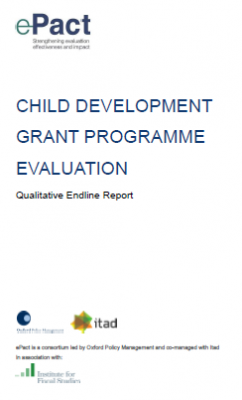Impact evaluation
We offer a range of services that evaluate the impact of programmes. We cover a wide spectrum of our partner’s needs, from statistical approaches (randomised control trials, quasi-experimental designs) through to theory-based approaches that focus more on understanding how impact occurs and who benefits. Wherever possible we use mixed-method approaches to provide a holistic understanding of impact.
Use the filters below to explore our work in impact evaluation.
Filter content:
Unforeseen benefits of the Millennium Villages Project in Northern Ghana
In this blog, Dee Jupp shares her experiences living in the home of an extended family in one of the Millennium Villages in...

Reflections on evaluating integrated rural development
The latest IDS Bulletin ‘The Millennium Villages: Lessons on Evaluating Integrated Rural Development‘ brings together a...

Mobilising for Development Independent Evaluation Manager (IEM)
The M4D evaluation was funded by DFID, conducted by Itad (as the IEM), and ran from 1 November 2014 to 15 May 2018, beginning...

Adolescents 360 Evaluation: How might we better meet the needs of adolescent couples with contraceptive counselling and services through Ethiopia’s Health Extension Program?
Itad is working in collaboration with the London School of Hygiene and Tropical Medicine and Avenir Health to independently...
Itad presents Millennium Villages Impact Evaluation findings with senior policy-makers from Northern Ghana
The Millennium Villages Impact Evaluation (MVEval) will be presenting its findings of the DFID-funded SADA Millennium Villages...

Child Development Grant Programme Evaluation Qualitative Endline Report
This report presents the findings of the third and final (endline) round of qualitative fieldwork for the evaluation of the...
Engaging adolescent girls in governance processes: lessons from Northern Nigeria
Itad conducted an independent impact evaluation of the DFID-funded Mobilising for Development (M4D) programme, which aimed to...
Statement on the impact evaluation of the Millennium Villages Project
An independent impact evaluation of a Millennium Villages Project (MVP) covering 35 villages in Northern Ghana was led by Itad...

Evaluating the results of BRACED projects in Ethiopia, Myanmar and Niger
The three-year, £110 million UK Department for International Development (DFID)-funded Building Resilience and Adaptation to...

Executive Summary: Impact Evaluation of the SADA Millennium Villages Project in Northern Ghana
The Millennium Villages Project (MVP) aims to demonstrate how the Millennium Development Goals (MDGs) could be achieved...

Impact Evaluation of the SADA Millennium Villages Project in Northern Ghana Annex A: Preliminary Statistical Analysis
The independent evaluation of the Millennium Village Project (MVP) in northern Ghana is based on quantitative and qualitative...

Impact Evaluation of the SADA Millennium Villages Project in Northern Ghana Annex E: Financing of the Millennium Villages Project (by sector)
This annex sets out the detailed finances of the Millennium Villages Project by sector and sub-sector. The analysis here...

Millennium Villages Project Briefing Paper No.5: What was the impact on health?
This Briefing Paper is the fifth in a series to communicate key points from the independent impact evaluation of the...

Resilience Results: BRACED final evaluation report
This report presents a synthesis of project-level final evaluations, carried out after three years of implementation of the...

Endline summary report: Impact Evaluation of the SADA Millennium Villages Project in Northern Ghana
This report presents the endline findings from an impact evaluation of the Millennium Villages Project (MVP) in northern...

Millennium Villages Project Briefing Paper No. 9: How is it being sustained?
This Briefing Paper is the ninth in a series to communicate key points from the independent impact evaluation of the...

